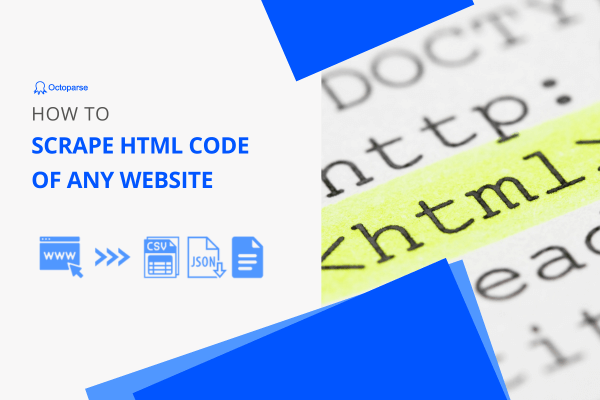
Understanding the Digital Landscape of Web Data Extraction
In the rapidly evolving digital ecosystem, websites represent complex repositories of information waiting to be unlocked. HTML extraction isn‘t just a technical skill—it‘s a strategic approach to understanding and leveraging web-based data. As digital landscapes become increasingly sophisticated, mastering web scraping techniques has transformed from a niche technical skill into a critical competency across multiple professional domains.
The Evolution of Web Scraping Technologies
Web scraping has undergone remarkable transformations since its early days. What began as simple screen-scraping techniques has now evolved into sophisticated, intelligent data extraction methodologies powered by advanced programming frameworks and artificial intelligence.
Historically, web scraping emerged in the late 1990s when internet content started becoming more structured and valuable. Early practitioners used rudimentary scripts to extract basic information, often facing significant technical challenges. Today, web scraping represents a complex ecosystem of tools, techniques, and strategies that enable professionals to transform unstructured web content into actionable insights.
Technical Foundations of HTML Extraction
Decoding HTML: The Structural Blueprint
HTML (HyperText Markup Language) serves as the fundamental structural language of web content. Understanding its intricate architecture is crucial for effective extraction. Each HTML document represents a hierarchical tree of elements, tags, and attributes that define how content is organized and presented.
Consider a typical HTML structure:
<!DOCTYPE html>
<html lang="en">
<head>
<meta charset="UTF-8">
<title>Website Title</title>
</head>
<body>
<div class="container">
<p>Paragraph content</p>
</div>
</body>
</html>This seemingly simple structure contains multiple layers of information that skilled web scrapers can strategically extract and analyze.
Core Extraction Methodologies
Web scraping professionals employ multiple approaches to extract HTML content, each with unique strengths and considerations:
1. Request-Based Extraction
Traditional request-based extraction involves sending HTTP requests to target websites and parsing the returned HTML content. This method works exceptionally well for static websites with consistent structures.
Python Example:
import requests
from bs4 import BeautifulSoup
def extract_website_content(url):
response = requests.get(url)
soup = BeautifulSoup(response.text, ‘html.parser‘)
# Extract specific elements
titles = soup.find_all(‘h1‘)
paragraphs = soup.find_all(‘p‘)
return {
‘titles‘: [title.text for title in titles],
‘paragraphs‘: [p.text for p in paragraphs]
}2. Browser Automation Techniques
For dynamically rendered websites using JavaScript frameworks, browser automation tools like Selenium and Puppeteer provide more robust extraction capabilities.
from selenium import webdriver
def scrape_dynamic_content(url):
driver = webdriver.Chrome()
driver.get(url)
# Wait for dynamic content to load
driver.implicitly_wait(10)
# Extract elements
dynamic_elements = driver.find_elements_by_class_name(‘dynamic-content‘)
return [element.text for element in dynamic_elements]Advanced Extraction Strategies
Handling Complex Web Architectures
Modern websites utilize increasingly sophisticated technologies that challenge traditional scraping approaches. Single-page applications (SPAs) built with React, Vue, and Angular require more nuanced extraction strategies.
Key considerations include:
- Identifying dynamic content loading mechanisms
- Managing asynchronous JavaScript rendering
- Implementing intelligent waiting strategies
- Handling complex DOM manipulations
Proxy and IP Management
Effective web scraping demands intelligent IP rotation and proxy management. Professional scrapers implement comprehensive strategies to:
- Distribute requests across multiple IP addresses
- Simulate natural browsing behaviors
- Avoid detection and blocking
- Maintain extraction reliability
Legal and Ethical Considerations
Web scraping exists in a complex legal and ethical landscape. Responsible practitioners must navigate:
- Website terms of service
- Copyright regulations
- Data privacy requirements
- Ethical data usage principles
Recommended Ethical Practices
- Always review
robots.txtfiles - Obtain necessary permissions
- Avoid overwhelming target servers
- Use extracted data responsibly
- Implement rate limiting
- Respect intellectual property rights
Performance Optimization Techniques
Efficient web scraping requires sophisticated performance optimization strategies:
Concurrent and Asynchronous Extraction
import asyncio
import aiohttp
async def concurrent_scrape(urls):
async with aiohttp.ClientSession() as session:
tasks = [fetch(session, url) for url in urls]
results = await asyncio.gather(*tasks)
return resultsIntelligent Caching Mechanisms
Implementing intelligent caching reduces unnecessary network requests and improves overall extraction efficiency.
Emerging Technologies in Web Scraping
Artificial Intelligence Integration
Machine learning and AI are revolutionizing web scraping by:
- Generating intelligent selectors
- Predicting complex extraction patterns
- Automatically classifying extracted content
- Adapting to dynamic website changes
Cloud-Based Extraction Platforms
Modern cloud infrastructures enable:
- Scalable extraction networks
- Distributed processing
- Managed proxy services
- Advanced data cleaning pipelines
Conclusion: The Future of Web Data Extraction
Web scraping continues to evolve, bridging unstructured web content with actionable insights. By mastering technical methodologies, understanding ethical boundaries, and leveraging cutting-edge technologies, professionals can unlock unprecedented value from digital information landscapes.
Recommended Learning Path
- Master programming fundamentals
- Learn multiple extraction techniques
- Understand web technologies
- Practice ethical data collection
- Stay updated with emerging trends
Essential Tools for 2024
- Beautiful Soup
- Scrapy Framework
- Selenium WebDriver
- Puppeteer
- Request-HTML
- Cheerio.js
Embrace the world of web scraping—transform raw internet data into strategic insights that drive innovation and understanding.










